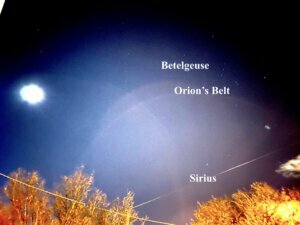If anyone in the DMV needs a break from their Earthly realities, three solar system bodies as well as the International Space Station (ISS) will be visible tonight at sunset.
First on the viewing list will be the full snow supermoon rising in the east around 5 p.m. If you have a clear view of the eastern horizon it is always spell binding to see a full moon rising as it can be distorted and colorful due to the Earth’s atmosphere. February’s full moon is named the snow moon because of the snow that is (NOT!) on the ground.
The full snow moon may appear a bit more luminous and larger than other full moons as it’s a supermoon. The snow moon will be at full phase, and therefore at its brightest Sunday morning at 2:33 a.m. EST. This is the first in a series of supermoons that will be occurring in the months to come.
Next up for your viewing pleasure is ISS rising in the northwest at 6:05 p.m. At a height of 22 degrees above the horizon, ISS will move across the sky towards the east-southeast horizon reaching a maximum height of 67 degrees and will be visible for 5 minutes.
ISS will disappear 11 degrees above the horizon. It is always mesmerizing to watch ISS fade into Earth’s shadow as it sometimes undergoes color changes that can best be seen in binoculars or a telescope. Tomorrow there will be a rocket launch from NASA’s Wallops Island Flight Facility carrying supplies to ISS. This event will be visible in the DMV so be sure to see a story on WTOP tomorrow.
Not to be out done, the gloriously beautiful and radiant Venus is in the southwest high above the horizon. Venus is easy to spot and becomes more noticeable as it gets darker. The second planet from the sun will be glowing in the weeks to come as it dominates the night sky.
Rounding out tonight’s view of the solar system is the planet closest to the Sun; the usually elusive Mercury. This is a great time to see the “Winged Messenger” as Mercury will be well placed in the sky about two fist widths to the lower right of Venus and about a fist-width above the southwest horizon. It is the brightest object in that part of the sky; only Venus is brighter. If you have binoculars it will help in your search and view.

As the night progresses the full snow supermoon will get higher in the sky and will accompany the stars of winter. The sky will take on a bluish color and the stars of Gemini, Orion and Canis Major take center stage. As you can see in my iPhone 11 astropic taken last night, the Moon and the stars easily shine through the lights of NW D.C.
Bundle up, get a comfortable sky watching spot and see the sky sights tonight. Breathe deep and enjoy…….
Follow me at Twitter @skyguyinva and my daily blog at www.whatsupthespaceplace.com to keep up with the latest news in astronomy and space exploration. You can email me at skyguyinva@gmail.com.







